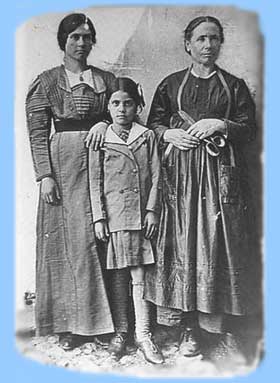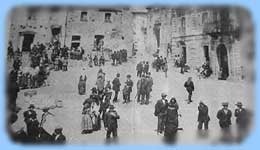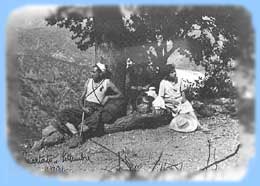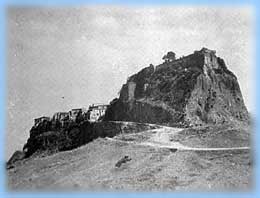 |
|
------- Part two - Corriere di Caulonia - march 1988..june 1988
Until here, the facts have regarded the figure of Nicola Ciccarello, known as Tocca. |
|||
|
|
The following day, 10th September 1847, the judge of Castelvetere, Raffaele Lo Schiavo, told Nunziante about the arrest of the four dangerous carbonari thanks to the loyalty of the Bourbonist citizens. As opposed to the day before, the weather was turning bad, when the four, under guard, were led to the chancellery of the “regio giudicato” for questioning. The chancellor was don Silvestro Prota, also a Mason, and the arrested men, who knew him, confided in him and handed him the compromising documents for him to destroy. |
||
|
After the interrogation, they were led to the prison of Gerace Marina where, on the 21st, they were joined by Ruffo and on the 22nd, by Rossetti and Manzoni, who had been arrested by the urban chief Giuglio Cappellari from Roccella. On the 1st October, the military commission gathered at the court of Gerace Sup. and was presided by the monarchist fanatic, colonel Rivaroli. Captain Nunziante played an important role in the trial which ended after the single hearing. He destroyed the interrogation reports drawn up by the judge Lo Schiavo and rewrote them in such a way as to portray the seven arrested men’s responsibility as minor. It was an action which could have saved their lives. A sudden turn of events, however, overturned the situation. When the Italian tri-colour flag found on Ruffo with the words “W l’Italia, W Pio IX” was used as evidence, the president of the court Rivaroll spat on it. Ruffo, Mazzoni, Salvadori, Bello and Verduci reacted, thereby offending the court, while Rossetti and Gemelli who, along with Mazzoni were from Roccella, stayed quiet and contrite. The first five were sentenced to death, Rossetti and Gemelli were sentenced to 15 years of imprisonment. Three months later, with the proclamation of the constitution, the two were set free and rejoiced in a political amnesty. The five men sentenced to death during the first hours of the following afternoon, were led to the church of S. Francesco to receive their last rites then were taken to the chosen spot and shot.
|
|||

|
During the period in which these facts happened, another noble figure of our society was coming into view: Vincenzo Niutta. He was a marginal figure in our history and we shall leave him as such while highlighting his qualities of skill, his intelligence, his capacity and his moral rectitude. He was born in Castelvetere on the 20th May 1802 from Ilarantonio Niutta and Marianna Deblasio, sister of the famous Ilarantonio Deblasio. When Vincenzo was only eighteen, he joined his uncle in Naples wanting to follow in his footsteps. Ilarantonio Deblasio, born in Castelvetere in 1767, in 1817, was fifty years old and, once the Grande Corte Civile delle Calabrie had been set up following the law n. 727, became its first president in Catanzaro. Two years later he was called to Naples’ Supreme Court of Justice of which he was president when he died on the 24th November 1834. |
||
|
Vincenzo Niutta displayed great
skills and intelligence, so much so that within political and juridical
circles his name was preceded by the adjective “Grande” (great): the
great Niutta. Because of a slight lisp, he limited his public speaking but he charged his sentences with a deep acumen which transformed them into jurisprudence. He belonged to the liberal current Masonic order and even the king Ferdinando knew it and in fact wanted to discharge him following the episode of the Gerace martyrs, but was afraid to do so, such was Vincenzo’s popularity and so powerful was the Masonic loggia of which he was a part. Why, though, did king Ferdinando have a moment of hesitation and want to dismiss Niutta? This is where we encounter a mess of information beginning with “it is said” and “it seems that” because, unfortunately, we have no documents to aid us which we do possess for everything said beforehand. The Bishop Perrone It appears that from his influential position in the Bourbonist court, Vincenzo Niutta managed to coax from the king his good will and obtain a signed recommendation assuring that the arrested carbonari from Castelvetere would be judged with clemency. In the Bourbonist kingdom, the leading reins of public affairs were held by the churchmen, so, the “recommendation” obtained in this way, reached the Bishop of Gerace, mons. Perrone, very swiftly. The bishop, however, decided to not notify the military court immediately but once the execution had taken place. Not only, he also notified his superiors in Naples that the five shot men had been Masonic conspirators, anti-bourbonists and rabid anticlericals, not worthy of the king’s help. Naturally, Ferdinando believed this version of the matters, and turned his anger onto Niutta. All the events are church secrets, so we must limit ourselves to heresay, however, it is certain that two days after the execution, on the 4th October, the festivity of San Francesco and the name day of the heir to the throne, the bishop Perrone, concluded his sermon with the words from the Psalm: convertisti planctum meum in gaudium mibh. In conclusion, regarding Vincenzo Niutta, it must be remembered that in 1859, as soon as Franceschiello (22/5/1859) came to the throne, he was elected President of the Supreme Court of Naples and was confirmed in this role by the dictator Garibaldi on the 7th September 1860 and to whom he handed the result of unanimity of the 21st October of the same year. With the Sabaudo kingdom, Niutta was nominated senator and at the same time, President of the Corte di Cassazione of Naples which substituted the Supreme Court of Justice. He died in Naples on the 1st of September 1867. Incidentally, we called up the name of the hero of the two worlds. He never came to Castelvetere but during his three days of rest in Ferdinandea (23rd-24th August 1869) guest of the Fazzari family, he sent a group of his voluntaries bearing the flag with his image to give to don Raffaele Campisi, Venerable master of the local Masonic Loggia. |
|||
 |
This is the end of a story which merits to be told more amply and in a better manner than ours. Not only to portray the figures of Cola i Tocca, but to portray the figures of the five martyrs who, certainly more than any other historical event, solicited the Constitution granted by Ferdinando II, on the 29th January 1848. We had begun with the intention
of not passing judgement on the actions of Tocca, allowing the reader
to draw his/her own conclusions, however, wanting to latch onto the
historical sources which describe the event, we also have to describe
the concepts, even if succinctly. |
||
| In his book, “Lotta e Martirio del Popolo Calabrese (1847-1848)” (Ediz. Brenner – Cosenza), Vittorio Visalli describes Tocca as “a young man half idiot and evil minded”. Dr. Ubaldo Franco, in his “Vita intima di un paese della Calabria nei secoli scorsi” refers to the fact that “Castelvetere was an important centre of the carboneria movement and when the unfortunate protagonists of the revolutionary attempt of 1847, hid in our mountains, they did not do so by chance, they hoped to find aid from their fellow carbonari, which they did not…” Dr. Franco hoped to one day be able to concentrate on the events of that time, but his destiny deprived us of this work which had it been written by him, would have been far better than our own attempt. Of these events, as of many others, we had discussed with Dr. Franco over documents in his possession and in ours, and were in agreement on the figures of Cola i Tocca also because the mother of Franco, Marianna Pachì, well remembered the stories told by her grandfather, Francesco Pachì, freemason and then, until Volturno, a follower of Garibaldi. We no longer keep all the documents and the proof of the membership of this great-grandfather to the revolutionary movements of that period from which Dr. Franco found the name of Francesco Pachì but we possess enough material which is there for anyone who wishes to examine it. Our theory on the figure of Tocca is the one we have so far described. A pinch of imagination, which is normal when one drinks, unfortunately, under the circumstances, led Tocca to betray the people he had been trusted with. |
|||
 |
The men wanted by the authorities because they were the heads of the revolution of September 1847, unlike Domenico Salvadori who left Bianco or Rocco Verducci who left Garaffa or Gaetano Ruffo who left Bovalino or Michele Bello who left Siderno or Pietro Mazzoni and Stefano Gemelli who left Roccella in order to reach the countryside of Castelvetere seeking a one off hiding place, came to us sure of finding protection in the hands of the local carbonari who would never have placed them in the hands of a “scoundrel” or an “idiot”. | ||
|
So we conclude, as we have done before, that Cola i Tocca was a traitor betrayed by wine. Here we lament the disregard that official history displayed towards the story of the five martyrs of Gerace which was a great deal more important than the Bandiera brothers episode. It is true that these last had been exalted by Mazzini as a strong example of the holocaust for freedom and the unity of Italy, while the five young men who fell at Gerace on the 2nd of October 1847, who were not Mazzinians but carbonari, have not received the recognition from official historiography which they deserved for sacrificing their lives in the name of freedom and the unity of Italy. They are certainly more worthy of historical gratitude than many of the figures which fill the school history texts and if their holocaust along with that of Domenico Romeo from Santo Stefano helped to move shake up, two months before Carlo Alberto, the resistant Borboni and press them into conceding the Constitution. It surprises us that even Montanelli who, in his voluminous Storia d’Italia (CDE spa) – Milano, entertains us with the lovers of Cavour but does not even marginally refer to the insurrectionary movement of Southern Italy during the Risorgimento. Let us close the topic of the carbonara activities and its consequences. Castelvetere was certainly one of the most consistent towns of the Ionian strip and who knows what kind of miracle was expected of it. It stayed silent and did not even intervene to free the arrested brothers from prison where they stayed for two days and two nights, closed up in the cells of the old monastery from where, many years later, others escaped via the sewer system and reaching the Vignacorta. We do not accept the statements of Visalli (Opl. Cit.) according to whom, suspecting the presence of the wanted men in our territory, the Mayor Nicola Asciutti unleashed the urban deputy chief Cerchiara (Domenico Ierace) who descended from campoli with eleven men whowerejoined by another eight from S. Nicola. It is unthinkable that a town of such modest dimensions such as Campoli, during a time when Castelvetere counted 6000 inhabitants, could dispose of eleven civil guards which can be regarded as equivalent to eleven of today’s Carabinieri. We remain of the opinion that to help the men to evade would have been a piece of cake more so because the streets were full of outsiders ready and willing to raise their hands and help. Instead, and it hurts to admit, the freemasons and the local carbonari, closed ranks in silence, and waited. So that when the waters had calmed, Roccella boasted 68 people involved in the movements while Castelvetere had only one: the citizen Alvaro Ilario di Vincenzo, a 26 year old farmer. (Visalli: op. cit). The freemasonry and the carboneria underwent a huge drop while Roccella emerged as depository of heroic virtue in the opposition of the Bourbonist regime and, even after the Unification of Italy, the local loggia worked on admirably, joining forces with that of Catanzaro in a brotherly embrace among men of culture. This activity carried on until the arrival of Fascism. Castelvetere, on the other hand, which took the glorious name of Caulonia on the 26th March 1865, ended all its revolutionary activities and the men set up the “nobility’s club” in order to pass their free time there. Once the fascist regime fell, after the 8th of September 1943, Roccella awoke again and the Loggia “Tommaso Campanella” reopened the doors of the temple. |
|||
 |
The brothers from Roccella, searching for novices, went from Locri to Caulonia and a year later they boasted a school of ethics which impressed itself throughout the Ionian strip. There were four Caulonians admitted to this organisation until 1945, and among them, a doctor. By this time, to conclude the local Masonic history, we must enter into details which could generate strong reactions. We are not afraid because – senectus docet – we limit what we say to what we are able to prove. |
||
|
The fascists thought that –massonically- supporting the Italian Government they would be able to put it in the position to suffer the least possible damage from the long drawn out armistice. Certainly, armed with this praiseworthy intention, the fascists gave way to the increase of the founding of new Loggias. In 1945, Dr. Ubaldo Franco asked to be a part of the loggia of Roccella. The brothers of Roccella and three of the four Caulonian brothers were enthusiastic of the idea, but the fourth Caulonian brother, the doctor, categorically forbade it. This story repeated itself every three months for more than a year and that “no” prevented Dr. Franco from being a part of the family. The other three local freemasons decided to set up “Triangolo” and proceed to initiate at least another four profanes in order to reach the number of seven, the minimum required, to be able to found a new Loggia. This was how, after 86 years, at the Oriente di Caulonia, the new Loggia “Giuseppe Garibaldi” was founded with Alfredo Collaci as its first Venerable Master. Dr. Franco, however, lacked the
patience to wait and he turned to the Loggia di Catanzaro where he was
welcomed with the first degree of Apprentice. He then participated in
the local Loggia’s works as visiting brother, without ever asking for
the affiliation though this was not permitted by the article 362 of
the Masonry’s General Statute. He preferred to remain in the order of
the Loggia di |
|||
|
|
|
||
 Copyright© 2000 Caulonia 2000 per continuare a cambiare - All rights reserved |
|||


